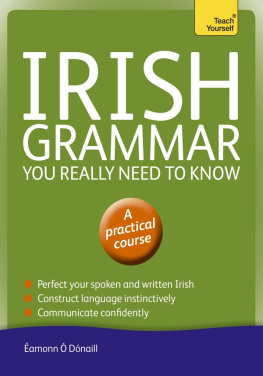You can teach nouns
Claudia Bertotto,Jimena del Azar-Pintaric and Margaret Hurley
Copyright 2013by You Can Teach Books, Inc. All rights reserved.
ISBN978-0-9879003-2-6
Cover design bySebastian Diaz Molaro
No part of this bookmay be reproduced in any form or by any electronic or mechanical means,including information storage and retrieval systems, without permission inwriting from the publisher. The only exception is by a reviewer, who may quoteshort excerpts in a review.
Thise-booklet covers the fundamentals of English nouns. It is part of the YouCan Teach Grammar series. This series covers the grammar required forteachers of English to speakers of other languages. It covers grammar conceptsand provides ideas for teaching the grammar in a classroom situation. Theteaching ideas are oriented toward communicative teaching methods. Readers maytest their own grammar comprehension with the self-practice quizzes.
Thefield of English teaching is described with many different acronyms, includingESL (English as a second language), EFL (English as a foreign language), ESOL(English for speakers of other languages) and ESP (English for specialpurposes). Throughout this series, the term ESL is used as an all-encompassingterm to refer to all categories of English language learning.
Thise-booklet focuses on the grammar of nouns. Because nouns are a fundamentalelement of language learning, the teaching ideas are oriented toward beginnerlearners. Other parts of speech are addressed in other e-booklets in theseries.
Formore information on these and other resources for teaching grammar, please goto www.youcanteachgrammar.com
Nouns
Nouns are words that name people, animals, things, places,abstract ideas, feelings, substances or qualities. The following are examplesof nouns.
man (person)
lion (animal)
table (thing)
beauty (abstract idea)
happiness (feeling)
park (place)
iron (substance)
stubbornness (quality)
If parts of speech are considered the building blocks of asentence, nouns would be the cornerstone. They are the most substantiveelements of communication. Without a noun (or noun equivalent) it is almostimpossible to build a sentence in English.
Nounforms
Nouns do not have a distinct form that immediatelyidentifies them as nouns. There are, however, some word endings which indicate thata word is probably a noun.

Some nouns are formed from verbs. Nouns formed by adding theending ing to the base form of a verb are known as gerunds. (See YouCan Teach Gerunds and Infinitives)
Compound nouns are nouns formed from two words, (forexample, classroom, basketball and woodworm), or lesscommonly, three or more words (son-in-law). Sometimes compounds arespelled with a hyphen, and sometimes not (sight-seeing, sunbathing).
Functions of nouns in a sentence
Nouns can have different functions in a sentence. They canbe found in the subject or predicate of a sentence. They are frequentlyaccompanied by modifiers, forming a noun phrase: the dog; an English teacher;an absolute coincidence. Examples of the different functions ofnouns or noun phrases are given in the sentences below.
Subject of a sentence

Object of the main verb

Subject complement of linking verbs such as be,seem, become, and appear

Object complement

Appositive (a noun or noun phrase which gives furtherinformation on another noun phrase which immediately precedes it, separated bycommas)

Quiz 1: Functions of a noun in a sentence
Identify the functions of the nouns underlined in thefollowing sentences.
Wenamed the baby Alec after his grandfather.
Whenyou buy something from a shop, you are making a contract .
Janiceand Boris are antique dealers .
The tower was built in 1989.
Lucerne,a magnificent city , is located on Lake Lucerne.
***In the classroom: Functions of nouns ***
When students understand sentence structure and haveappropriate vocabulary, they can generally pick out the nouns. One fundamentalpoint of confusion is that in English, many words that are nouns can alsofunction as verbs. For example: The book is on the table vs. Iwant to book a table for two at The Ritz.
In addition to an understanding of structural rules, wordstress can be a significant differentiator in these cases, as the distinctionbetween nouns and verbs is often a matter of shifting the stress. For example: rec ord (noun) vs. re cord (verb).
Noun placement
Nouns can be preceded by determiners. (See You Can TeachArticles, Determiners and Quantifiers) Singular countable nouns alwaysrequire a determiner (for example, a, an, the, another,every, some, my, this).
anegg
everyperson
thatman
yourpen
Plural nouns are not preceded by a determiner when theyrefer to things or people in general.
Thepeople in my neighbourhood are generous.(specific people)
People are becoming more aware of thesituation. (people in general)
Nouns come after descriptive adjectives. (See You CanTeach Adjectives)
A bluecar is parked outside.
His narrow, brighteyes scaredme.
A noun can follow a preposition as the object of thepreposition. (A preposition followed by a noun or pronoun is called aprepositional phrase. The preposition introduces the phrase and the noun is theobject of that preposition.)
He lived inParisformonths.
A noun can be placed before another noun to describe ordefine it; the noun that precedes another noun is functioning as an adjective.
The kitchen walls are painted blue.
(noun kitchen functioning as an adjectivedescribing the noun walls)
Noun types
The following table gives a complete rendition of thecharacteristics of nouns. Each of the characteristics is explained in furtherdetail below.
Table 1: Noun types

















